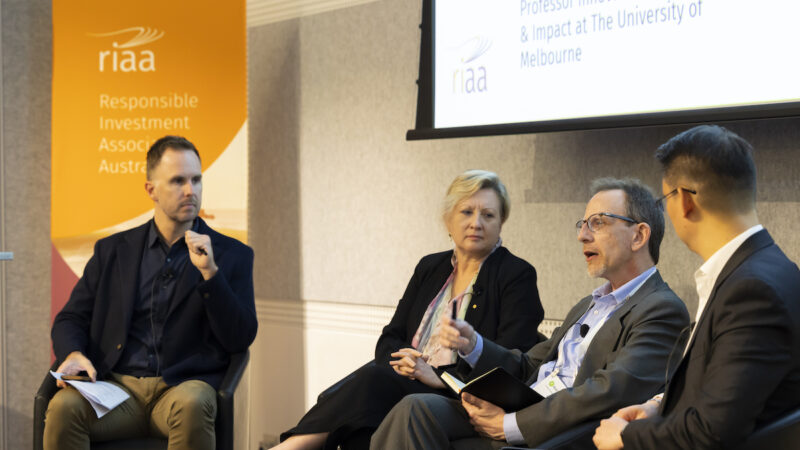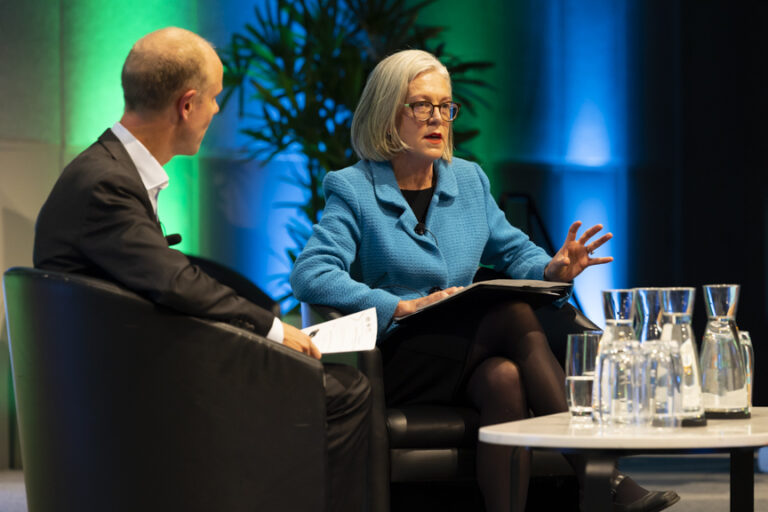I hosted a panel at the RIAA conference not long ago, and after watching the video of the session, I thought it was worth sharing some of the 🔑 insights.
I was joined on stage by a global mix of impact legends: Sean Gilbert (GIIN), Chris Chen (American Century Investments) and Rosemary Addis (Mondiale Impact).
We were there to talk about impact investing, and more specifically ‘Lifting the bar on impact reporting in an era of transparency and accountability’.
I opened with a question about definitions, and Sean set the tone by explaining that labels are less important than outcomes.
“We think of impact as being those investment strategies that are trying to accelerate a fairly specific outcome. There’s a big difference between talking about being impactful and having an impact investing strategy.
Being impactful is where an investor takes some action, focussed on a positive outcome. Like stewardship, they take an action and can be accountable for it.
That’s different from where you have an impact investment strategy that’s built around trying to achieve a defined outcome. And importantly, that the companies in the portfolio work together in achieving it.”
From Impact Measurement to Management
Impact measurement has come a long way, but now that we have the data, we need to use it to inform decision-making that maximises positive impact.
Rosemary Addis explained that it’s a little bit like building a rocket to get to the moon, you don’t land the rocket THEN build the systems, you need to look forward, not back.
“The choices we make in the next few years will make all the difference to the future. It’s not a neutral landscape in which we’re operating.
Measurement is necessary, but it’s not sufficient. If we think about this as our moonshot, then, just like when we invented space travel, we need to invent new tools.
If we think of the measurement as being the navigation systems to get us to the moon, then we realise we don’t plug in the data at the beginning and expect we’re going to land there. We need the capability to be able to fly it, we need that orientation where everybody from the top to the bottom to say, we’re here to land a person on the moon.
The management part is about embedding impact considerations into strategy, including into the risk considerations; including the risk that we won’t actually achieve the outcomes for the people we’re here to serve, this one is rarely reported.”
Sean suggested that the quality of impact reporting can be an indicator of the level of strategic thought done upfront:
“Reporting is the output of a process, and where you see a gap in the coherence of a report, if for example, there’s no targets or no clear explanation of what the fund is trying to achieve, that’s probably a reflection that they don’t have a strategy that’s clearly thought through.”
Differentiating Impact in Public Markets
There was a suggestion that public-market impact funds should use a different name, but Chris offered a quick counter-point:
“Rather than ALL public-impact funds changing their name, a big chunk of them should rename themselves to be thematic funds. They can look very similar from a high altitude, even when they’re clearly very different.”
Touché.
Will ISSB Cover Impact Issues? The Double Materiality Question
It was getting late in the afternoon and the topic went deep into some wonky sustainable accounting issues. The ISSB standards have come hot on the heels of TCFD, which saw broad adoption. But, what will be its scope? Will it only cover direct financial impacts of sustainability issues, or will go further, to cover real world impacts?
“For the first time we have international convergence around corporate sustainability reporting. But the system will need to make decisions about thresholds in terms of sustainability, from a company perspective. Is it only issues which affect the financial performance of the company? Or is it also about the company’s impact on the broader world?
Essentially it’s asking, should it cover single or double materiality.
My personal view is it will be increasingly difficult to answer that question without having a better appreciation of the broader sustainability context, and an organisation’s impact in the world, to decide what’s financially material. These risks around climate are getting to be so significant that they will start to have direct financial effects. Even if that’s the starting point, it’s going to be increasingly important for companies.
We should recognise it for the step change that it is but it won’t be a complete answer and it’s also not going to be the only requirement that companies have to be responsive to.”
NB. Since the conference, the ISSB has launched its inaugural set of reporting standards. It’s a major step forward, offering companies and investors a baseline for reporting on sustainability and climate-related issues.
This explainer from Pathzero offers some good insights.





